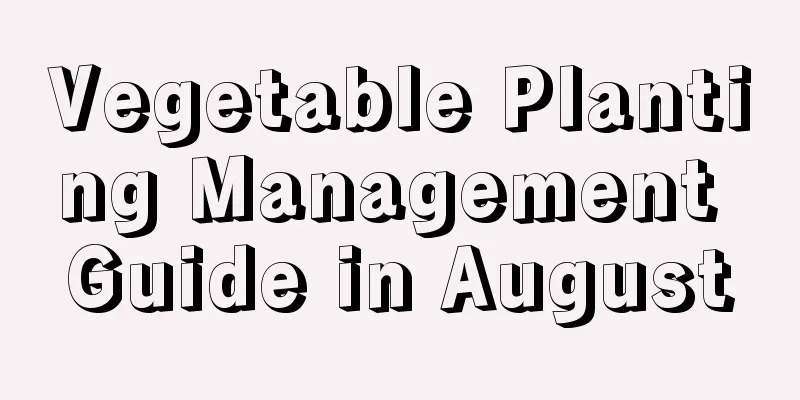Vegetable Planting Management Guide in August

|
August is the busy season for autumn vegetable sowing, seedling raising, planting and field management, but the hot and rainy climate in August poses challenges to the growth of vegetables and also brings the risk of high incidence of diseases and pests. So what should we pay attention to in vegetable planting management in August? Let’s learn more about it below. 1. Sowing and seedling raising According to local climatic conditions, choose suitable vegetable varieties for sowing or seedling raising. Vegetables that can be sown include leafy vegetables such as bok choy, Chinese cabbage, spinach, celery , as well as cauliflower, tomatoes, eggplants, etc. When raising seedlings, pay attention to preventing the seedlings from growing too fast and grasp the appropriate time for transplanting. 2. Moisture management The temperature is high in August and vegetables require a lot of water, so sufficient water supply should be ensured. But be careful to avoid overwatering as this may cause root rot. Water-saving irrigation methods such as drip irrigation and sprinkler irrigation can be used 3. Shade and cool down For cool-loving vegetables, such as lettuce and spinach, you can use a shade net to reduce the light intensity and avoid growth stagnation or yellowing caused by high temperature. If necessary, a spray system can be used to cool the vegetable leaves, replenish moisture on the leaves and alleviate heat damage. 4. Apply fertilizer at the right time In August, some vegetables, such as leafy vegetables, enter a rapid growth period and require timely top dressing and nutritional supplementation. It is recommended to use quick-acting nitrogen fertilizers, such as urea, but care should be taken to control the dosage to avoid excessive use that will cause vegetables to grow too tall. 5. Intertillage and weeding Carry out inter-row cultivation and weeding in time to keep the soil loose and well-ventilated. At the same time, soil can be cultivated in combination with intertillage to stabilize the plants and prevent lodging. 6. Pest and disease control After harvesting the previous crop of vegetables, it is necessary to clean up the dead branches and leaves in time and pay attention to the prevention and control of various diseases and pests. This includes downy mildew, soft rot, cabbage looper, fall armyworm, diamondback moth, etc. of vegetables such as melons, beans, cruciferous vegetables, tomatoes, peppers, eggplants and aquatic vegetables (such as water chestnuts and arrowheads) to ensure the health and yield of subsequent plantings. 7. Harvest in time Pay close attention to the maturity of vegetables and harvest them in a timely manner to avoid over-ripening and deterioration in quality. Vegetables that are usually suitable for harvesting in August include peppers, tomatoes, eggplants, cucumbers, amaranth, lettuce , leeks, lentils, cowpeas, etc. The above is the sharing of the fruit tree planting and management guide in August. Growers need to pay close attention to weather changes and flexibly adjust management measures to effectively respond to the challenges brought by high temperatures and heavy rains in August.
|
<<: Cabbage planting tips and methods
>>: What vegetables can be grown in August?
Recommend
Garlic's growing environment and growing conditions
Garlic Growth Environment and Conditions Garlic p...
Is hyacinth poisonous?
The toxicity of hyacinth comes from the bulbs. To...
How to fertilize the plant
1. Growth habits They like an environment with hi...
When is the best time to sow parsley?
Parsley sowing time Parsley is a plant of the gen...
How to water and plant potted kapok
1. How to water potted kapok Kapok plants are nat...
Where do tea seeds come from?
Where do tea seeds come from? Tea seeds are mainl...
Advantages and disadvantages of Romantic Baby Rose
The plant height of Romantic Baby Rose is only fo...
How often should you water your cherry tree?
How often should you water your cherry tree? Cher...
When is the right time to plant beans?
As a popular vegetable, beans are grown in almost...
What to do if the leaves of the money tree turn yellow in spring
1. Increase the temperature Reason: The temperatu...
When is the best time to plant dahlias?
The right time to sow dahlias Dahlia belongs to t...
How often should I water the anthurium?
1. Watering frequency Generally, water it once ev...
Hosta flower meaning
1. Tranquility: The Hosta blooms quietly. The col...
How to propagate Begonia
1. Division method It is usually carried out in e...
Jasper cultivation methods and precautions
1. Soil Jadeite needs to be grown in well-drained...









